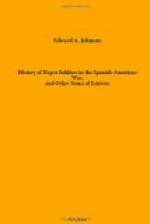The latter’s half brother, Jose Maceo, was captured early in the war and sent to the African prison, Centa; whence he escaped later on with Quintin Bandera and others of his staff. The last named Negro Colonel is to-day a prominent figure. “Quintin Bandera” means “fifteen flags,” and the appellation was bestowed upon him by his grateful countrymen after he had captured fifteen Spanish ensigns. Everybody seems to have forgotten his real name, and Quintin Bandera he will remain in history. While in the African penal settlement the daughter of a Spanish officer fell in love with him. She assisted in his escape and fled with him to Gibraltar. There he married his rescuer. She is of Spanish and Moorish descent, and is said to be a lady of education and refinement. She taught her husband to read and write and feels unbounded pride in his achievements.
The noted General Jesus Rabi, of the Cuban Army, is of the same mixed blood as the Maceos. Another well-known Negro commander is General Flor Crombet, whose patriotic deeds have been dimmed by his atrocious cruelties. Among all the officers now swarming Havana none attracts more admiring attention than General Ducasse, a tall, fine-looking mulatto, who was educated at the fine military school of St. Cyr. He is of extremely polished manners and undeniable force of character, can make a brilliant address and has great influence among the masses. To eject such a man as he from a third rate foreign restaurant in his own land would be ridiculous. His equally celebrated brother, Col. Juan Ducasse, was killed last year in the Pinar del Rio insurrection.
COLORED MEN’S ACHIEVEMENTS.
Besides these sons of Mars, Cuba has considered her history enriched by the achievements of colored men in peaceful walks of life. The memory of Gabriel Concepcion de la Valdez the mulatto poet, is cherished as that of a saint. He was accused by the Spanish government of complicity in the slave insurrection of 1844 and condemned to be shot in his native town, Matanzas. One bright morning in May he stood by the old statue of Ferdinand VII. in the Plaza d’Armas, calmly facing a row of muskets, along whose shining barrels the sun glinted. The first volley failed to touch a vital spot. Bleeding from several wounds, he still stood erect, and, pointing to his heart, said in a clear voice, “Aim here!” Another mulatto author, educator and profound thinker was Antonio Medina, a priest and professor of San Basilio the Greater. He acquired wide reputation as a poet, novelist and ecclesiastic, both in Spain and Cuba, and was selected by the Spanish Academy to deliver the oration on the anniversary of Cerantes’ death in Madrid. His favorite Cuban pupil was Juan Gaulberto Gomez, the mulatto journalist, who has been imprisoned time and again for offences against the Spanish press laws. Senor Gomez, whose home is in Matanzas, is now on the shady side of 40, a spectacled and scholarly looking man. After the peace of Zanjon he collaborated in the periodicals published by the Marquis of Sterling. In ’79 he founded in Havana, the newspaper La Fraternidad, devoted to the interest of the colored race. For a certain fiery editorial he was deported to Centa and kept there two years. Then he went to Madrid and assumed the management of La Tribuna and in 1890 returned to Havana and resumed the publication of La Fraternidad.




